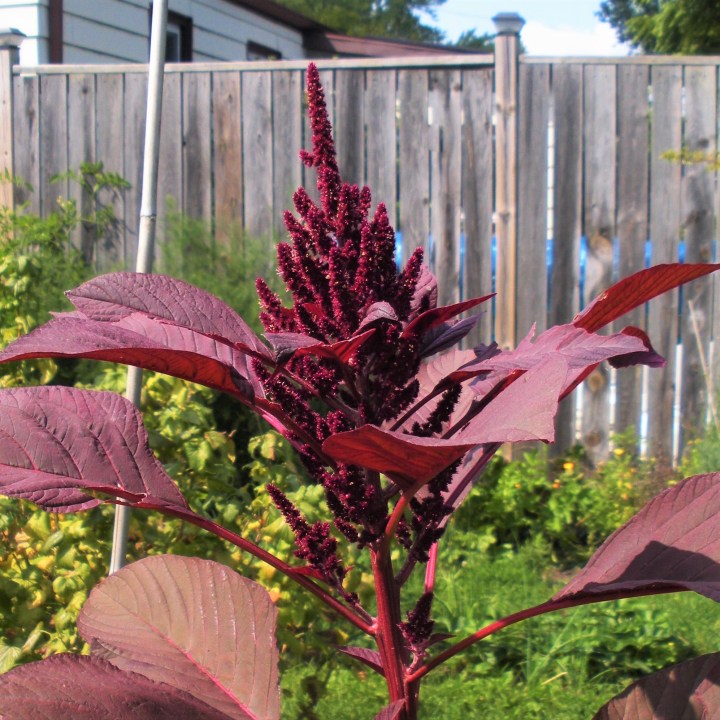
The Amaranthaceae botanical family is divided into several subfamilies, serialized as a vast collection of weeds, bushes and also many edibles. From greens (such as spinach and Swiss chard), inflorescences (for example, see huauzontle in my previous posts), roots (beets), to pseudo-grains, such as quinoa and the subject of this post, Amaranth (Amaranthus sp.)
The genus Amaranthus is a whole entity of its own, comprising 70 different species; although there is archeological evidence of Amaranthus in the Old World, many species are native to the Americas. The Greek roots of the word Amaranth mean “unfading flower”, due to its resistance to inclement weather, poor soil and pests (bugs, fungus, or bacteria.) The Nahuatl name is huāuhtli and it was cultivated in pre-Hispanic Mexico for its seeds, consumed in beverages (similar to atole), as a substitute of corn (where this crop was hard to cultivate), and even as part of a ceremonial treat made with toasted or ground and cooked seeds and agave syrup, or honey (yes, there was honey in pre-Columbian MesoAmerica!)
There are mainly three species of Mexican amaranth; I bought a burgundy variety (Amaranthus hypochondriacus) from West Coast Seeds™ a couple of years ago and grew it that same season (2017). It was a great year for my amaranth crop, I guess very sunny but not extreme; the plants grew to about five feet (1.52 m) tall and produced beautiful velvety inflorescences, loaded with seed:

I cooked with some of the edible leaves when they were young, and saved a couple of tablespoons of seed. Raw baby leaves added a bright colour and bite to salads that was everything but vapid, and cooked larger ones provided a decent spinach substitute. I was proud to see that my seeds looked just like the ones from a package of Bob’s Red Mill™:

I have not grown it again because, although good in all the applications mentioned above, I thought the flavour of the leaves was too strong for my family’s taste and, as for the seeds, it took me a lot of time to separate them from the chaff (some debris may still be appreciated in the little bag with my seed).
It was still fun to grow, and even just as an ornamental, it is a beautiful plant. Maybe I will give it another try next year …
I am joining Cee’s Flower of the Day (FOTD) challenge for September 26, 2019.








Thanks for the information 🙂
LikeLiked by 1 person
Glad you liked it!
LikeLiked by 1 person
We cook amaranth leaves with potatoes and a bit of garlic and it tastes yum! The seeds are used with jaggery to make sweetmeat.
LikeLike
Yummy! I sometimes cook mustard greens like that, too. In Mexico, popped seeds are mixed with something like jaggery (piloncillo) to make a sweet treat; I am trying to develop a post with recipes for that and other uses of amaranth seed.
LikeLiked by 1 person
Mustard greens and spinach are also cooked in the same manner sometimes. Though we usually pressure cook mustard greens with a bit of spinach, lots of garlic, ginger and chillies. Then we add a bit of corn flour to thicken it. The tempering is usually done with more garlic and dried red chillies.
Amaranth seeds are also added to pulses and amaranth flour is used during fasting.
LikeLike
Thank you for all the tips, I shall try them soon!
LikeLiked by 1 person
You are welcome, Irene.
LikeLiked by 1 person
Love this! Whenever I see amaranthus, I sing Elton John’s song, “Love Lies Bleeding” (which is what folks around here call amaranthus caudatus.)
LikeLiked by 1 person
Such wonderful photos for today. Thanks for playing along 😀
LikeLiked by 1 person
Thank you, Cee!
LikeLike
Huh! That’s quite a utilitarian beauty!
LikeLike
I know, right? Beautiful and smart!
LikeLiked by 1 person
It does look very beautiful, Irene. Does it attract beneficial insects?
LikeLike
I did not notice any increased activity, but they are supposed to be attractive to butterflies. The birds certainly liked to munch on the seeds.
LikeLiked by 1 person
Well, that is a bonus. 🙂
LikeLiked by 1 person
It is very pretty and would work well as an accent plant in the yard. I haven’t tried amaranth seeds in anything. I’ve used quinoa before and didn’t care for it as much as I like brown rice. Quinoa also caused some stomach upset, not sure why, as I have a cast iron stomach. I admire you growing the amaranth and harvesting the seeds!
LikeLike
Thank you, MsJadeLi! I have only eaten popped amaranth, which is used in sweets, and it is very mild, but I am going to try cooking with it for a future post. I know epazote (herb in the same family) has poisonous seed, so I have always wondered if the bitterness of quinoa comes from a minuscule amount of a toxin or something, but that’s just a guess.
LikeLiked by 1 person
Interesting!
LikeLiked by 1 person